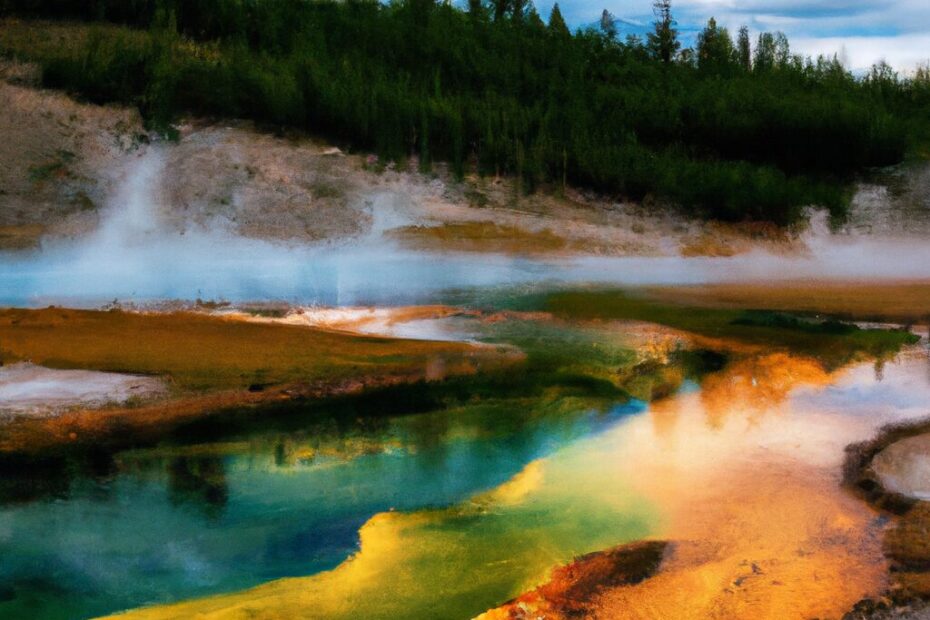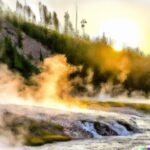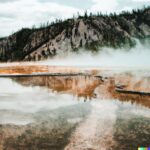Old Faithful, a natural wonder in Yellowstone National Park, has captured the awe and imagination of visitors for generations. This article will explore the history of Old Faithful, from its discovery to its geology.
Discover why Old Faithful is famous and what makes it unique, as well as how it contributes to the surrounding ecosystem. Learn about the frequency of its eruptions and get tips on how to visit, including the best time to go, nearby attractions, accommodation options, and safety precautions to consider.
What is Old Faithful?
Old Faithful is a renowned geothermal feature located in Yellowstone National Park, known worldwide for its spectacular geyser eruptions with precise timing.
Visitors from around the globe flock to witness Old Faithful’s majestic eruptions that reach heights of up to 184 feet. The geyser’s eruptions are so regular that they occur approximately every 60 to 110 minutes, earning it the name ‘Old Faithful‘ for its dependable schedule.
The geothermal displays are a sight to behold, providing a natural and captivating showcase of Yellowstone’s volcanic activity. As one of the most predictable geysers in the world, Old Faithful offers a unique and unforgettable experience for nature enthusiasts and curious observers alike.
History of Old Faithful
The history of Old Faithful traces back to the geological processes of Yellowstone National Park, highlighting its significance in the realm of geothermal activity and the remarkable predictability of its eruptions.
How Was Old Faithful Discovered?
The discovery of Old Faithful unfolded amidst the exploration of geysers around the world, showcasing the impact of volcanic activity on the formation of such natural wonders.
Geysers, like Old Faithful, are intriguing manifestations of the Earth’s geothermal energy. The unique combination of underground hot water and pressure leads to the spectacular eruptions that captivate visitors.
The first recorded encounter with Old Faithful dates back to the Washburn Expedition in 1870, where this awe-inspiring geyser was named for its predictable eruptions. This natural wonder has since become an iconic symbol of Yellowstone National Park and a testament to the geological forces at work beneath the Earth’s surface.
What is the Geology of Old Faithful?
The geology of Old Faithful unveils a thermal landmark with an iconic cone structure, symbolizing the unique geological processes at work beneath its surface.
Its thermal characteristics make it a compelling natural wonder that draws visitors from far and wide to witness its spectacular eruptions. The iconic cone shape of Old Faithful is a result of the mineral deposits left behind by the geyser’s continuous eruptions over centuries, creating a distinctive silhouette against the Yellowstone landscape. The geological forces that have shaped this renowned geyser include underground magma chambers, hydrothermal activity, and the gradual build-up of pressure that culminates in its regular eruptions, further solidifying its status as a geological marvel.
Significance of Old Faithful
The significance of Old Faithful transcends its reputation as a tourist attraction to embody a natural wonder shaped by intricate geological formations.
Its geothermal activity is a testament to the Earth’s fascinating processes, with the geyser’s eruptions being a spectacle that highlights the power and beauty of nature. Visitors are not just witnessing a routine event; they are observing a manifestation of millions of years of geological activity.
The regularity of Old Faithful’s eruptions, with intervals lasting up to 90 minutes, showcases the predictability of nature while also reminding us of its unpredictability and the awe-inspiring forces that lie beneath the surface.
Why is Old Faithful Famous?
Old Faithful garners its fame due to the mesmerizing eruption patterns that showcase the relentless geological activity simmering beneath its surface.
These eruption patterns, characterized by their reliable regularity and impressive heights, have captivated visitors for generations. The geyser’s iconic displays serve as a testament to the continuous underground movements and pressure buildup, creating a spectacle that never fails to awe spectators. It’s not only the sheer size and frequency of the eruptions that draw people in but also the predictability of Old Faithful’s shows, allowing visitors to experience the raw power and beauty of nature up close and personal.
What Makes Old Faithful Unique?
Old Faithful stands out for its unique blend of periodic eruptions that can be accurately predicted, offering insights into the underlying geological forces at play.
With its dependable schedule of eruptions, Old Faithful has become a favorite amongst visitors to Yellowstone National Park. This iconic geyser showcases the mesmerizing power of nature, as spectators eagerly await the next awe-inspiring display. The predictability of Old Faithful’s eruptions is a remarkable phenomenon, allowing scientists and park rangers to study the intricate mechanisms driving this natural spectacle. By understanding the patterns of its eruptions, researchers can delve deeper into the mysterious workings of geothermal features, providing valuable knowledge for both scientific exploration and park management.
How Does Old Faithful Contribute to the Ecosystem?
Old Faithful contributes to the surrounding ecosystem by enhancing its natural beauty and providing thermal energy derived from volcanic heat sources beneath the surface.
This iconic geyser in Yellowstone National Park not only attracts millions of visitors each year with its breathtaking eruptions but also plays a crucial role in sustaining the delicate balance of the ecosystem. The thermal energy generated by Old Faithful supports a diverse range of microorganisms that thrive in the extreme conditions, forming a unique ecological community. The hot springs and geysers in the area help regulate temperature and nutrient cycling, contributing to the overall health of the ecosystem. In this way, Old Faithful represents a fascinating intersection of geology and biology.
What is the Frequency of Old Faithful Eruptions?
The frequency of Old Faithful’s eruptions follows a distinct cycle, mirroring the patterns observed in other geysers such as the Steamboat Geyser within Yellowstone National Park.
These geysers, including Old Faithful, operate on a predictable timetable due to the underground geological processes that regulate their eruptions. Old Faithful erupts approximately every 90 minutes, demonstrating remarkable consistency in its interval between eruptions.
In contrast, the Steamboat Geyser is known for its sporadic eruptions, sometimes remaining dormant for years before displaying intense activity. The variations in eruption patterns between these geysers offer valuable insights into the diverse mechanisms at play beneath the Earth’s surface, shaping the awe-inspiring geothermal features of Yellowstone.
How to Visit Old Faithful
Planning a visit to Old Faithful offers a remarkable opportunity to witness one of the most iconic geysers in Yellowstone National Park and experience the awe-inspiring beauty of this natural wonder.
Visitors should ensure they check the predicted eruption times of Old Faithful, as this geyser is known for its regular and reliable eruptions, making it a spectacle not to be missed.
Arriving a bit early to secure a good viewing spot is advisable, allowing ample time to admire the surroundings before the remarkable display.
Exploring the boardwalks around Old Faithful provides different vantage points to enjoy the eruptions and capture stunning photographs of this majestic natural phenomenon.
What is the Best Time to Visit Old Faithful?
Determining the best time to visit Old Faithful involves considering factors like the timing of eruptions, temperature conditions, and the allure of witnessing mineral deposits in the geyser basin.
Timing plays a crucial role in enhancing the overall experience of witnessing Old Faithful in all its splendor. By knowing the typical eruption schedule of the geyser, visitors can plan their visit to coincide with these awe-inspiring displays of natural beauty. Being mindful of temperature variations can ensure a comfortable and enjoyable visit, especially during extremes of hot or cold.
The vibrant colors and intricate mineral formations surrounding the geyser basin provide a mesmerizing backdrop that adds to the unique charm of the area, making it a must-see for nature enthusiasts.
What Are the Nearby Attractions?
Exploring the vicinity of Old Faithful reveals a myriad of captivating attractions, including other geothermal features, hot springs, and intriguing hydrothermal phenomena that enrich the overall experience.
Visitors to this enchanting region can immerse themselves in the mesmerizing beauty of Grand Prismatic Spring, the largest hot spring in the United States, boasting a kaleidoscope of vivid colors. The bubbling mud pots at Fountain Paint Pots provide a unique sight to behold, while the steam rising from the Norris Geyser Basin creates an otherworldly atmosphere. Each of these attractions offers a different perspective on the fascinating geological activity that shapes the Yellowstone landscape, making the visit to Old Faithful an unforgettable journey of discovery.
What Are the Accommodation Options?
Choosing suitable accommodation options near Old Faithful ensures a comfortable stay amidst the geysers of Yellowstone National Park, offering convenient lodging choices to complement the visit.
Whether you prefer the rustic charm of cozy cabins or the luxury of upscale resorts, there are plenty of options to suit your taste and budget near this iconic geyser. For those seeking a more immersive experience, campgrounds with stunning views are also available for a closer connection to nature. Family-friendly lodges and budget-friendly motels provide diverse alternatives for visitors exploring the wonders of Old Faithful.
What Are the Safety Precautions to Take?
Taking necessary safety precautions when visiting Old Faithful involves being mindful of the thermal features, steam emissions, and hot water hazards in the vicinity to ensure a secure and enjoyable experience.
To stay safe around thermal features, it is crucial to adhere to designated pathways and not wander off marked trails. Be cautious of the unpredictable nature of these geothermal features, as the ground may be thin and fragile in certain areas. Never attempt to touch or enter any hot springs or geysers, as the water temperatures can exceed boiling point and cause severe burns. It is advisable to maintain a safe distance from all thermal features to prevent accidents and ensure personal safety during your visit.
Last Updated on February 7, 2024 by Jon Waraas – Originally Posted: February 7, 2024

I’m Jon Waraas, and I’ve been navigating the online world since 2006. By day, I’m the proud owner of some eCommerce gems, and by night, I’m the voice behind the adventures on Waraas.Com.
My heart, however, belongs to the wild beauty of Yellowstone National Park. I’ve got a collection of websites dedicated to sharing the wonders of this natural masterpiece. Oh, and did I mention? I’m currently building my own cabin inside the ghost town of Gilmore, Idaho – a cabin with tales to tell!
When I’m not immersed in the digital realm, you’ll find me lacing up my boots for a good hike or setting up camp under the star-studded sky.




